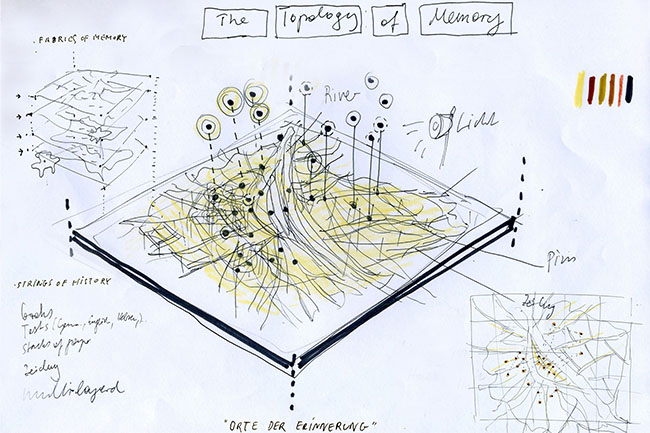Memory Map


















THE MEMORY MAP – A Topology of Remembrance
The Memory Map is a physical as well an interactive digital map to engage people in the legacy of the Holocaust on the streets of Vienna. To create the physical map, the artist Nikolaus Gansterer has developed an intricate, sculptural representation Vienna’s urban layout based on letters of citizens of Vienna who tried to escape the town in the years 1938-1945. Through high-quality photography, Gansterer’s art piece was transformed into a dynamic and digital map which can be used to navigate 38 Holocaust memory zones around the city.
At all these sites acts of Nazi discrimination, exclusion, violence, and humiliation took place between 1938 and 1945. Thirty eight of these addresses have been chosen to become “memory zones” representing multiple victim groups of the Holocaust in Austria: Jews, Roma and Sinti, mentally and physically disabled, homosexuals, dissidents (communists, socialists and Christian Democrats), Slovenian partisans, and Jehovah’s Witnesses.
Nikolaus Gansterer first scanned the Archival letters coming primarily from survivor families in the US and then cut the text into strips, assembling the lines of communication into a three dimensional city map of Vienna. The fragile intimacy of the letters developed as a large-scale map delivers new insights about the massive scale of destruction to a city, a nation, and to a people. The letters, reading literally as pathways of remembrance, provide a direct testimony to the past, challenging viewers to imagine the lives of the writers who inhabited this city, abruptly expelled and deported from their homes. Through high-quality photography, Gansterer’s art piece was transformed into a dynamic and original digital map. While the ostensible purpose of the map was for the project’s smartphone app, the actual map is now an object of consideration.
At the intersection of art and history, the Memory map represents a new way for the public to preserve and engage with the legacy of the Holocaust. Each digital memory zone on the map displays fresh research – both text and image – so that the map serves as an educational tool for people around the world. People in Vienna are also be able to use the Smartphone app integrated into the map to be lead on a tour of the 38 sites. While the 38 sites represent the primary focus of the memorial project, it is the Memory Map itself that evokes the heart and soul of memory transported through time. (Karen Frostig)
Concept & idea: Nikolaus Gansterer
Year: 2013
Dimensions: 200 x 300 x 25 cm
Material: Paper, text, pins, on wooden plates
Location: The Memory Map by Nikolaus Gansterer was donated as a permanent installation to the Jewish Museum, Vienna, where it also can be visited. The art work was developed in the framework of the Vienna Memorial Project, initiated by Karen Frostig.
Assistance: Anna Scher
Photographer: Birgit Graschopf
Acknowledments: many thanks to the people and families who contributed archival letters : Danny Frankel, Lucy Gandsas, Karen Frostig, Melissa Hacker, Julie Jones and Dennis Jones, Miriam Keesing, Donald. O. Kollisch and his family, Vladimir Melamed, Ellen Schoen, Judith Stratton, Ruth Wolman.
App development: was realized in partnership with Kapsch AG and in cooperation with CSS GmbH, Vienna (Isabel Bimstingl, Johannes, Widmann, Hans-Peter Zillner). Download the Vienna Project App, available for iOS and Android.
Publication:
– ‚Wien von Oben. Die Stadt auf einen Blick‘, Sandór Békési, Elke Doppler (Eds.), Metroverlag, Vienna, 2017. ISBN 978-3-99300-303-6
Reviews:
– ‚Messen, spielen, orientieren‘, Brigitte Borchhardt-Birbaumer, in: Wiener Zeitung, (22.03.2017)
– „Memory cartography and the policy of space“, Bahar Majdzadeh, in: ‚Beyond forgetting – persecution / exile / memory – transdisciplinarity in design, performance and education‘, Gerhard Kampe, Thomas Kampe (eds.), Cuvillier Verlag, Göttingen, 2020. ISBN 9783736973107
Exhibitions:
23 March – 17 September 2017
“WIEN VON OBEN. DIE STADT AUF EINEN BLICK”
The group exhibition “Bird’s-Eye Vienna” takes a glance on historical and contemporary practices of mapping the city of Vienna at Wien Museum, Austria. Nikolaus Gansterer’s Memory Map is showcasing an outstanding example „of interweaving bio-graphies and topo-graphies within the urban fabric“. Curated by Sándor Békési and Elke Doppler.
3 November 2014
UNSERER STADT / OUR CITY!
On the 3 November festive inauguration by director Danielle Spera, curator Werner Hanak and Karen Frostig (The Vienna Project) of the permanent installation of the Memory Map by Nikolaus Gansterer at the Jewish Museum, Vienna.
18 October 2014, 19:30 – 21:00
„THE VIENNA PROJECT“
Closing ceremony of the Vienna Project at the Austrian National Library with readings, performances and live projections. Karen Frostig, Oskar Deutsch, Chaim Eisenberg, Oliver Rathkolb, Rubina Moehring, Gabriele Heinisch Hosek, Philip Reichel, Maxi Neuwirth, Marine Windsberger, Margit Fischer, Rudolf Sarkoezi, Ruth Wolman, Johanna Rachinger, Gerald Bast, Dieter Flury, Matthias Schorn, Doron Rabinovici, Nikolaus Gansterer, Daniel Niemand, Stefan Arztmann, Elisabeth Wildling, Jerome Segal, Georg Traska, Kabren Frostig Levinson, Ildiko Meny, Alexander Matthias Kosnopfl, Waltraud Jungwirth, Johanna Taufner, Kate Melchior, Christian Wind, Peter Mlczoch, Barbara Kintaert, and the Wiener Philharmoniker. ao.
Installation and presentation of the Memory Map by Nikolaus Gansterer and readings from the scanned letters. Please download the full programme of the evening here!
23 Oct 2013, 19:00
„THE VIENNA PROJECT“
Opening night of the social action memorial project The Vienna Project at Odeon Theatre, Vienna with a dense program of speeches, performances and later on in the evening at the „Parcours des Erinnerns“ with projections along the Danube Canal. Nikolaus Gansterer develps a intricate Memory Map which will be accessible via the Vienna Project-app programed by the CSS team. The memorial project was initiated by Karen Frostig, developped in close collaboration with the University of Applied Arts Vienna and will result in various manifestations within Vienna till Fall 2014.

